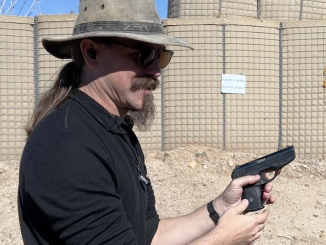When South Africa decided to replace the R1 rifle (a metric FAL), they chose to adopt the Israeli Galil. Both nations had similar environmental issues with blowing sand (in northwestern South Africa particularly), and Israel was one of the few nations willing to trade arms with South Africa in the 1970s. The Galil ARM was adopted as the R4 rifle, with the initial batch of guns purchased directly from IMI, and a licensing agreement put in place to follow those up with domestic South African production.
These would be followed later by the R5 carbine, and the abortive attempt at the R6 carbine. In addition, semiautomatic copies of these rifles were also available on the civilian market at the LM-4, LM-5, and LM-6. Today we will look at the differences between the South African and Israeli guns, the changes made through production, and the variation in the different types. Everything you wanted to know about the South African Galils!




“Israel was one of the few nations”
Interestingly both supported one-side during Biafran War, more generally Supported by part of Wikipedia query: https://en.wikipedia.org/wiki/Nigerian_Civil_War
is at least untypical for 1960s war.
Is Wikipedia query true in given them?
On same side United Kingdom (member of NATO) and Bulgaria (member of Warsaw Pact).
How many divisions by then had Vatican? How much war matériel Vatican delivered?
What interests have Haiti there?
is: “(…)given(…)”
should be: “(…)giving(…)”
UK–Nigeria was a former British Colony? Yes?
USSR–the article you posted clearly shows that the Soviets thought their policy should be consistent with that of the Congo crisis? i.e. do not support Moise Tshombe and the Katangese separatists, but instead support the so-called “simbas” and anyone speaking in the name of the martyred Patrice Lumumba in favor of a united ex-Belgian Congo/Congo Kinshasa?
Bulgaria–How is it that Bulgaria was never made a part of Russia or a Soviet republic? I don’t think any Slavic Warsaw Pact nation was more slavishly loyal to the USSR’s party line, no?
Israel has long sought to curry favor with various sub-Saharan African states as a foil to the pan-Arabist nationalism and outright hostility of much of the Islamic world, particularly in North Africa. Israel and the apartheid government were allied throughout the 1970s and 1980s. IDF and SADF= “what’s in a name?”
Now do the SS-77…
Huh, this escalated quickly, from intermediate-cartridge rifle into general purpose machine gun, in around 3rd comment
🙂
I second that request…
Ian, did the R5 shoot softer than the valmet you fired earlier this year (very similar rifle)? If I recall I thought you stated that you found the Valmet in 5.56 “bouncy” in full auto. Do you feel there was a significant difference?
Some time back I looked at Galil and did not really like it. Reason: too heavy and generally clumsy. No wonder SA soldiers wanted broad sling. No wonder IDF adopted M16 instead.
Oh btw, Uziel Gal had low opinion of it.
What a lovely Balishnikov.
Very interesting Ian. I was Infantry Corps in SADF with 6 SA Inf battalion and we were issued with the 1st R4’s in January 1980. we were deployed in April 1981 on SWA / Angola Border. Our R4’s still had the Galail wooden grips, smaller sights, carry handle (which was actually grinded off because we used the handles to gippo carrying the rifle in shoulder on parades – and the Sargent Major’s did not like that!! = you had to suffer…) the problem with the free floating firing pin was the use in our anti-landmine vehicles = Buffels. in the 10 man troop carrier, there was rubber-grips/locks for the R4 rifles, and R1,s where you pushed the barrel into. and rest on another very hard rubber baseplate. If you go on patrol, the rifle was on stand 0, ready to fire, only on S. round in chamber. If you hit holes in the field, or bumps in roads, and the shock was had on rifle, the pin fired the round off. Within 1month of us at border, the rifle-engineers came and fitted the spring in firing pins right there in the field on patrol. One of our troops los an eye in such incident. We never saw the “Effies” version. only the springs, and had our weapons for 1,5 years on border duty – never had spring replaced. Lots of action and firing, especially in Operation Protea, one of the biggest operations into Angola on Aug/Sept 1981. thanks very interesting. Tertius Zitzke, Pretoria SA. More info like this on FB group: Grensoorlog / Borderwar 1966 -1989
R5’s were also standard issue to South African OPS medics. – Operational Medical Orderlies ( sortof special service medics )
I served in the SADF from 1987/1988 and used my R4 in a significant manner during basics, training (I was artillery, 4th Field out of Potch’) and operations Hooper and Modular in Angola. I appreciated the ruggedness and low maintenance of the R4…anyone know of anyone selling R4 or civilian LM5 in the US?
LM4/5/6 builds are definitely out there, with a couple of well known builders. Biggest issue is sourcing the parts. I’ve been collecting the parts for twenty years or a bit more, still am looking for some stuff lol.
Cool! The R5 is a gun solid snake uses in Metal Gear Solid Ghost Babel. My bro has one of the golani galil’s Century used to bring in and it’s a peach. Great guns.